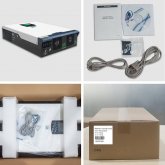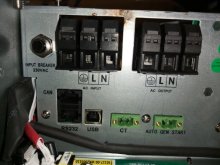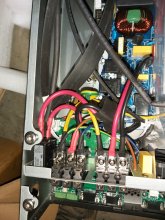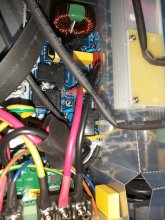When you started to inform about the Revo II, I warned you that they are 220v only.
You wrote:"Ya I knew they were 220 volt units, do you know if it is a high or low frequency inverter?"
To me it still feels like you want to make it magical split phase.
It's not.
You knew at the start, most people on the forum told you, the producers told you, the specifications tell you.
Again, hat's off for the first installer, perhaps ask them to rewire as they where able to make it magical work.
(Without the magic smoke)
Anyway, no point in pointing fingers, work towards a solution.
Some more information about how autotransformers work:
One solution might be the Victron autotransformer 100A.
That should fit your needs.
Specification sheet attached.
Pricing I've seen for USA $650-700,-
Victron is high end (with higher price), middle classes autotransformer should be about $350,- and probably widely available in USA.
It's confusing matter, split phase that actually uses ground and have an L1 and L2 +, where sine wave just have L and N, grounding not used except for safety.
Diving deeper and things like 180 degree phase shift, starts getting really confusing when you keep in mind that outside N/S America also know 3 phase 400volt setups.
it almost gives me the same headaches when I tried to grasp E = mc2....
I simply miss the background to be able to understand all parts involved.
So I just accept that USA uses different, Not compatible.

For own power usage, it's not mentioned in the specs ?? (Or in other autotransformers I found)
What I could learn from how it operates, it's not constant, but mostly load depending.
Own use should be relatively low.
For any inverter I like to tell people that you will use 5% of its maximal capacity always as standby or own power usage.
For the Revo, I use about 2% on my 3200 watt units.
Just that I like to tell that lead acid only absorbs 85% of the power you put in and get back. 15% is lost.
For LiFePO4, it's 95%
Rough numbers, and yes, on the negative.
Lead acid can do up to 92%, LiFePO4 98% and inverters down to 1.5%
If I would start with those numbers, most people would be disappointed with what they get.
To keep expectations realistic...
(And get a positive feeling)
If you have 20.000 watt inverter, that will use about 5% = 1000 watts.
For the 4 x 5.5kw Revo II units, +/- 0.5kwh, always.
No matter how much you are loading them.
Yes, there is a thing called sleep mode, that many companies wave with as standby power usage...
Don't fall for that trick.
You are never using standby sleep mode.
In parallel, they are all awake. Always.
So, for your possible 22kw power production you always use 12 kWh per day, being able to produce way over 500 kWh per day.
Sure , 12 kWh per day sounds a lot.
500 kWh is a lot.
No matter if it goes directly from solar to AC or from battery, you will have losses.
Besides those losses, your system needs to be up and running.
If you are a taxi driver in a crowded town, your average milage goes down a lot.
If you would extract the gasoline used standing still (not driving, producing) your milage probably isn't that bad.
But you don't care as you can't stop and start the car that much times, it would cost more then keep it stationary.
You simply accept that stationary, all the things that use in your car (stereo, air-conditioning, power steering, lights, etc.) Use energy/ gasoline.
Inverters aren't that much different.
They have their own power consumption that needs to be there, besides the conversion losses.
For the price class, Revo II from Sorotec with its 2% is not bad, not bad at all.
I have had 3 different brands, using 1.8 to 6%.
My 6000W units used just 100 watt, sadly design was badly made for small loads (under 500w) that made them do the magic smoke. (It didn't turn on the fan)
EASun 3000watt used whopping 6%.. that, amongst many different issues.
If you thought about buying... Don't.









